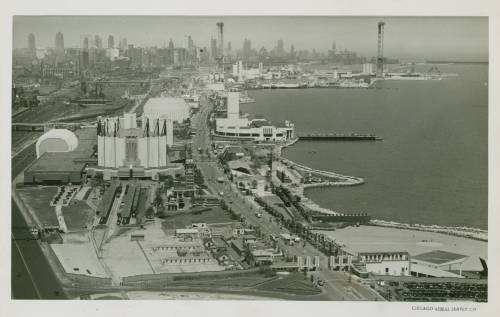A Century of Progress International Exposition: Organization and Planning
Proposed in 1927 by a number of wealthy businessmen and politicians in Chicago, the idea to hold a second World’s Fair in Chicago prominently featured the oil tycoon Rufus C. Dawes as chairman of the exposition board and the linchpin of the venture. Viewed as an eminently capable individual, Dawes boasted not only immense personal wealth, but crucial connections in the political arena, with a brother in the White House serving as vice president under Calvin Coolidge. Giving an impassioned speech to Chicago civic leaders and Mayor “Big Bill” Thompson on December 13, 1927, Dawes envisioned a second Chicago World’s Fair even bigger and better than the Columbian Exposition forty years before. Highlighting the resurgence of recent international expositions and the opportunity to re-brand Chicago as a city of progress rather than a site notorious for gangster violence and racial tension, Mayor Thompson quickly endorsed the plan to hold a World’s Fair celebrating the 100th anniversary of the city’s incorporation in 1833.
In contrast to the Columbian Exposition in 1893, Rufus C. Dawes and the organizers of the Century of Progress committed to financing this second Chicago World’s Fair without governmental support or taxpayers’ dollars. This commitment to private and individual support would shape the World’s Fair in a number of ways over its two-year run. As the start of the Great Depression in 1929 loomed on the horizon, the Fair was well positioned to weather the economic strain of the impending downturn, financed by Dawes’ wealthy contacts, private corporations, and individual citizens. The organizers of the Century of Progress raised nearly $10 million through the sale of bonds to the public and another $20 million in private and corporate funds. Their appeal to the public not only acted as potent publicity for the coming Fair, but also engendered a sense of ownership amongst the general populace, a more democratic feeling surrounding the Fair and its formation.
In reality, an “Old Boy’s Club” of wealthy white men in Chicago, who knew each other through various social clubs and organizations, organized and managed the Century of Progress. From this group of men, Rufus C. Dawes chose military engineer and veteran Lenox R. Lohr to act as General Manager of the Fair. Major Lohr’s storied managerial prowess would play a critical role in helping to maintain public confidence in the Fair even through the disastrous stock market crash of 1929 and the ensuing Great Depression. With Dawes and Lohr at the helm, the 430-acre Century of Progress on Northerly Island in Chicago seemed too great to fail.



